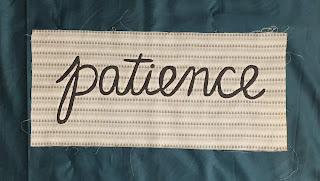Writing in Fabric- Text Quilts
Writing with Fabric
Last month I started creating words in fabric. There are now twenty-two words spread out on the guest room floor; blocks in many shapes and sizes. I've just realized this has become the text version of a sampler. I'm not sure where it's going yet, but I'm improving my skills through experimenting and exploring the possibilities and limitations of this medium in producing text.
(To see how this all started, check out this link:
Many of these blocks are variations of block letters mixed with a few appliquéd "o's" and other circles, combined with straight lines. But I've wanted to break out of that approach and I've been uncertain how to accomplish it.
On a trip to the library recently, I picked up a (new-to-me) book on quilting history in which I found a lovely example of "reverse appliqué." This technique involves placing one piece of fabric behind the other, cutting out a shape, then turning under the edges to reveal the fabric underneath. "Patience" is my first attempt at reverse appliqué, which seems so fitting to me; it required much patience to execute this block. There's a lot to improve upon in this sample, but the technique adapts easily to the curves of cursive writing. So, now I have more options for creating text with fabric.
There are a couple of lessons to absorb here.
I went on creating text for 21 blocks in just about the same way, - building letters with basic shapes. It was a process of addition and it worked just fine, but it was limiting... and getting a bit boring, to be honest. Then I shifted the way I thought of the text. Instead of thinking of the letters as the solid, I thought of the "negative space" in and between the letters as solid. Letters emerged in the space between these shapes when the background fabric was cut away in a subtraction process.
This is much like a sculptor works; adding or subtracting materials in the process of creating. I have no doubt these methods apply to any number of other disciplines. If you're stuck in one way of looking at something, try mixing it up a bit. The bridge, between what I wanted to do and actually making it a reality, was to look at the challenge from a different, fresh perspective.
I would also point out that I found new inspiration in this technique, only when I ran across that history book. Chances are somebody, somewhere, has already thought of a solution you can adapt for your own purposes. So, being open to (new-to-you) ideas is always productive, and "old" things can be relevant, exciting, and inspiring.
Of course having a little patience with yourself also helps.
Note: "negative space" is an art term which refers to the space between solid objects, like the rectangles between spindles on a banister or triangles between the spokes in a bicycle wheel.




Are you going to include any of your text blocks in the VMQG quilt?
ReplyDeleteI did contribute two words to the VMQG quilt and I'm really looking forward to seeing how it all comes together; guild members have contributed text such a wide variety of text for this quilt. It's a talented group!
Delete